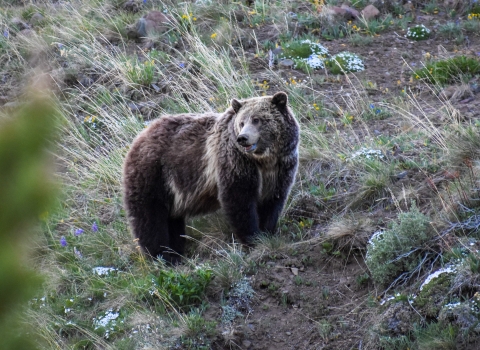MISSOULA, Mont. – The U.S. Fish and Wildlife Service (Service) is seeking the public’s input on a draft conservation strategy for the Northern Continental Divide (NCDE) grizzly bear (Ursus arctos horribilis) population. The final document will be the post-delisting management plan for the NCDE grizzly bears and their habitat.
Since listing in 1975, the NCDE grizzly population has increased in numbers and distribution thanks to the protections of the Endangered Species Act and our many state, federal, and tribal partners who have implemented recovery actions, coordinated research efforts, and improved habitat management.
“We developed this strategy because maintenance of a healthy, recovered grizzly population depends on the effective continuation of many partnerships to manage and conserve the Northern Continental Divide Ecosystem grizzly bear population and its habitat,” said Noreen Walsh, Mountain-Prairie regional director. “By involving the public, we aim to arrive at a scientifically-based strategy that not only ensures the persistence of grizzlies in the Northern Continental Divide Ecosystem, but also works for the people living in the places that grizzlies call home.”
Biologists are seeking public review and input on the draft strategy, which describes the regulatory framework for management and monitoring of the NCDE grizzly bear population and its habitat upon delisting, i.e., recovery and removal from the Endangered Species Act’s (ESA) Federal List of Endangered and Threatened Wildlife.
The key to public support and successful management of grizzly bears is to balance multiple land uses, public safety, and careful consideration of grizzly bear needs. Human-caused mortality is the limiting factor for nearly all grizzly bear populations in the world and this Conservation Strategy aims to manage mortality at sustainable levels through habitat protections that minimize mortality risk while emphasizing conflict prevention, conflict response, and decisions grounded in scientific data and monitoring.
The conservation strategy demonstrates the adequacy of regulatory mechanisms that will remain in place post-delisting to assure the health of the NCDE population. It describes the management and monitoring direction to maintain a recovered grizzly bear population in the NCDE and documents the commitment of the following signatory agencies through a Memorandum of Understanding: Montana Fish Wildlife and Parks, the Montana Department of Natural Resources and Conservation, the Blackfeet Nation, the Confederated Salish and Kootenai Tribes, the U.S. Forest Service, the National Park Service, the U.S. Geological Survey, the Bureau of Land Management, and the U.S. Fish and Wildlife Service. Implementation of the strategy will allow the signatories to continue managing NCDE grizzlies and their habitat according to the agreements reached during the interagency process of developing the document.



